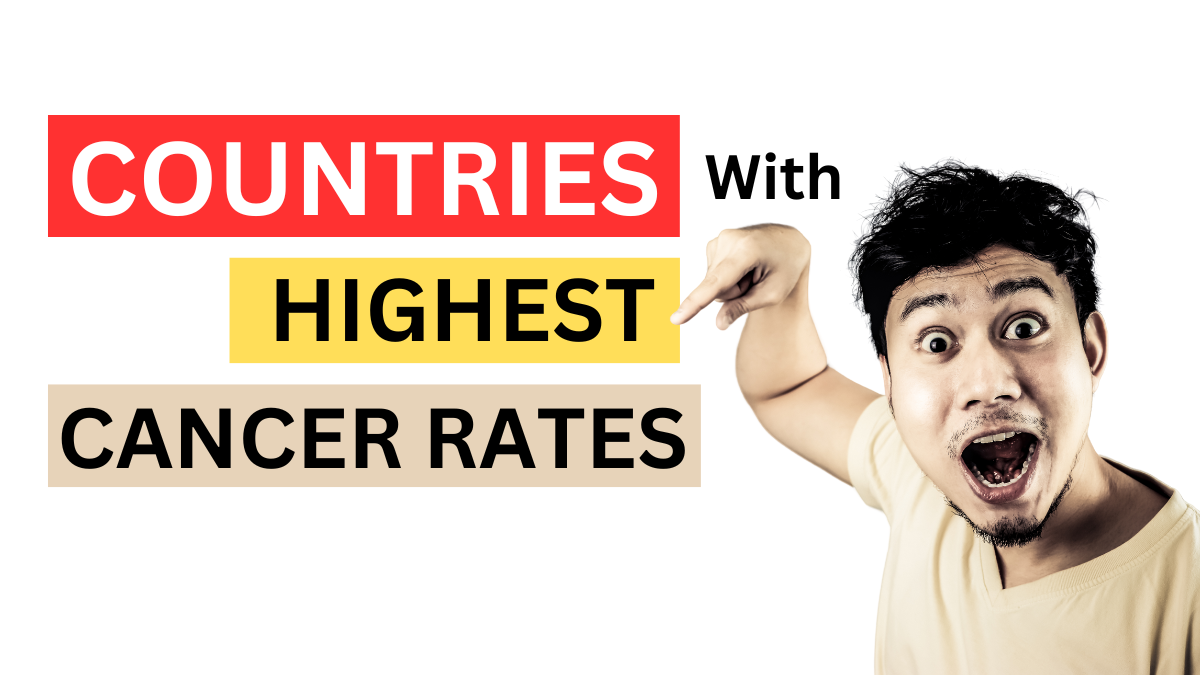Contents
The Countries with the Highest Cancer Rates
Highest Cancer Rates Did you know that cancer is one of the leading causes of death worldwide? A staggering number of lives are impacted by devastating disease each year. In this article, we delve into the countries with the highest cancer rates, shining a light on the global impact of this health concern. Join us as we explore factors contributing to these statistics, share personal stories, and discuss the importance of awareness and prevention.

Cancer Rates Around the World: A Closer Look
Cancer is a global problem, affecting people of all ages, genders, and backgrounds. However, certain countries bear a heavier burden when it comes to cancer incidence rates. Let’s examine some countries that stand out in terms of cancer prevalence and explore the reasons behind these alarming statistics.
Countries with the Lowest Breast Cancer Rates 2024
1. Australia: A Sunburnt Country Battling Skin Cancer
Australia, often called the “sunburnt country,” unfortunately tops the list when it comes to skin cancer rates. With its proximity to the ozone hole and a predominantly fair-skinned population, Australians are at a higher risk of developing skin cancer, mainly melanoma. The extensive outdoor lifestyle and love for sunbathing further contribute to these alarming statistics.
“Australia has the highest skin cancer rates in the world due to its intense UV radiation levels and lack of protective ozone layer.” – Australian Skin Cancer Foundation
2. Denmark: A Struggle with Lung Cancer
When it comes to lung cancer, Denmark has one of the highest rates globally. Smoking plays a significant role in the development of lung cancer, and Denmark has had a long history of high tobacco consumption. Although efforts have been made to reduce smoking rates and implement strict tobacco control policies, the impact on lung cancer rates is still prevalent.
“Denmark has a higher lung cancer incidence than other Nordic countries due to past high tobacco consumption rates.” – Danish Cancer Society
3. Hungary: A Battle Against Digestive System Cancers
Hungary encounters an elevated rate of cancers affecting the digestive system, including esophageal, stomach, and colorectal cancers. Dietary factors, such as high consumption of processed meats, alcohol, and the prevalence of Helicobacter pylori infection, contribute to the increased risk of these cancers. Early detection and lifestyle modifications remain crucial in combating the high incidence rates.
“Hungary faces a significant burden of digestive system cancers due to a combination of dietary factors and lifestyle choices.” – World Cancer Research Fund
4. South Korea: Rising Thyroid Cancer Rates
In recent years, South Korea has witnessed a dramatic rise in thyroid cancer diagnoses. Improved access to healthcare, advancements in diagnostics, and heightened awareness may partly explain the surge in reported cases. However, it is essential to distinguish between overdiagnoses and true increases in incidence rates. Further research is ongoing to understand the underlying causes fully.
“South Korea has seen a remarkable increase in thyroid cancer diagnoses, raising questions about potential overdiagnosis.” – Journal of Korean Medical Science
Global Efforts in Cancer Prevention and Treatment
While reflecting on the countries with the highest cancer rates, it is crucial to emphasize the significance of prevention and early detection. Cancer, in many cases, can be avoided or treated effectively with timely interventions. Various international organizations, such as the World Health Organization (WHO) and non-governmental organizations (NGOs) focused on cancer research, are actively working to educate communities, promote healthy lifestyles, and improve cancer care.
“Prevention and early detection are paramount in reducing the impact of cancer globally, enabling more lives to be saved.” – World Health Organization (WHO)
Here are some key initiatives and preventive measures individuals can take to reduce their risk of cancer:
- Embrace a Healthy Lifestyle:
- Quit smoking and avoid exposure to secondhand smoke.
- Maintain a balanced diet rich in fruits, vegetables, and whole grains, while reducing processed meat and alcohol consumption.
- Engage in regular physical activity to maintain a healthy weight.
- Protect Yourself from the Sun:
- Apply sunscreen with a high sun protection factor (SPF) and wear protective clothing when spending time outdoors.
- Seek shade during peak UV radiation hours (typically 10 am to 4 pm).
- Stay informed and Get Screened:
- Be aware of common cancer symptoms and seek medical attention if any concerns arise.
- Follow recommended screening guidelines for various types of cancer, such as mammograms for breast cancer or pap smears for cervical cancer.
“By adopting a healthy lifestyle, protecting ourselves from the sun, and staying informed, we can take steps towards preventing cancer and saving lives.” – American Cancer Society
In conclusion, the countries with the highest cancer rates face unique challenges due to a combination of factors. Skin cancer, lung cancer, digestive system cancers, and thyroid cancer are prevalent in specific regions, highlighting the need for tailored strategies to combat these diseases. By spreading awareness, promoting prevention, and investing in research, we can work towards a future where the burden of cancer is significantly reduced.
Remember, you have the power to make a difference in your own life and the lives of others. Take charge of your health, support cancer research initiatives, and help us fight this global battle together.
External Links:

